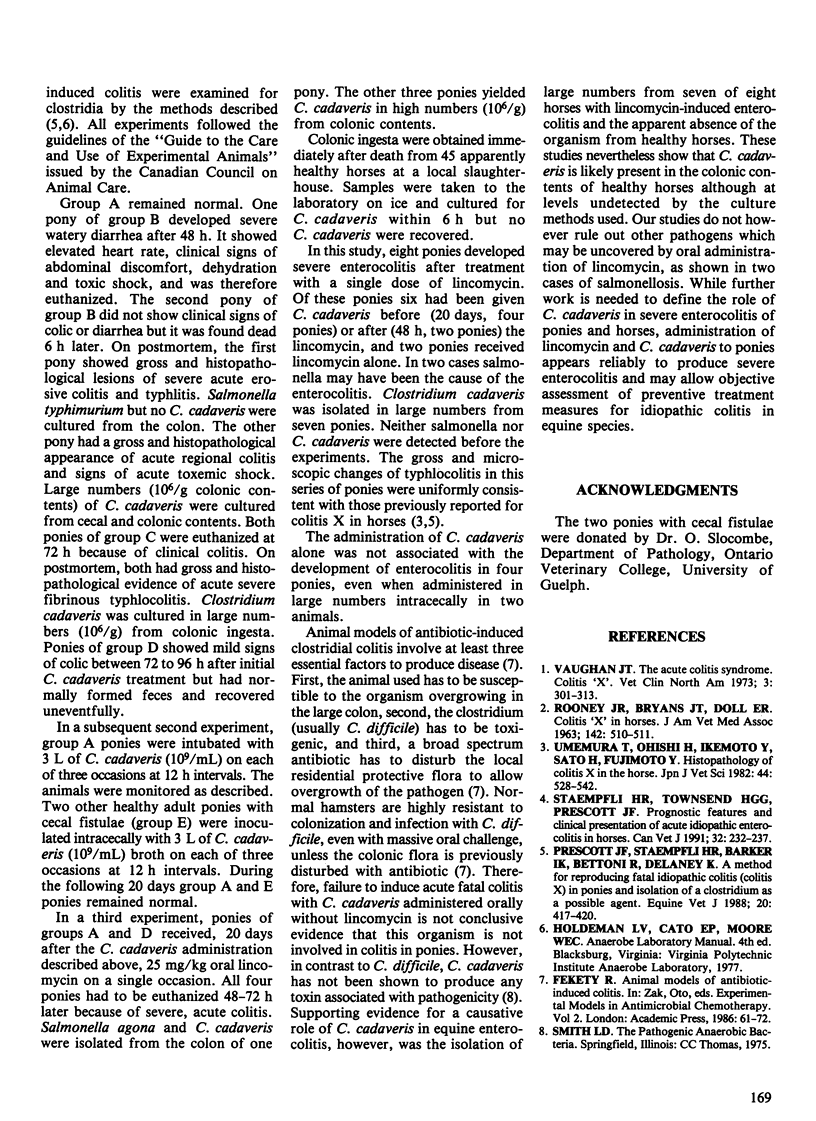Abstract
Four groups of two ponies, free of fecal Salmonella and Clostridium cadaveris, were treated as follows: Group A, control group; B, single nasogastrically administered dose of lincomycin (25 mg/kg) followed 48 h later by 3 L of C. cadaveris (10(9) organisms/mL); C, the same dose of lincomycin as group B; D, the same dose of C. cadaveris as group B on each of three occasions at 12 h intervals. Groups A and D remained healthy, but groups B and C developed severe colitis 48-56 h (B) or 72 h (C) after administration of lincomycin. Three ponies were euthanized and one in group B died. Clostridium cadaveris was isolated at about 10(6)/mL of colonic contents from these ponies, but one pony in group B also yielded Salmonella typhimurium from the colon. Subsequent challenge of group A ponies (3 L of C. cadaveris 10(9)/mL, three times at 12 h intervals) did not produce colitis. Nasogastric administration of lincomycin (25 mg/kg) to group A and D ponies, 20 days after administration of C. cadaveris, resulted in severe colitis in all ponies within 48-72 h. Salmonella agona was isolated from the colonic contents of one pony and C. cadaveris (10(6)/mL) from all four ponies. Clostridium cadaveris was not isolated from the colonic content of 45 healthy horses examined immediately after death. These studies confirm the potential for lincomycin to induce severe enterocolitis in ponies and implicate C. cadaveris further as a cause of "idiopathic colitis" in ponies.
Full text
PDF

Selected References
These references are in PubMed. This may not be the complete list of references from this article.
- Prescott J. F., Staempfli H. R., Barker I. K., Bettoni R., Delaney K. A method for reproducing fatal idiopathic colitis (colitis X) in ponies and isolation of a clostridium as a possible agent. Equine Vet J. 1988 Nov;20(6):417–420. doi: 10.1111/j.2042-3306.1988.tb01563.x. [DOI] [PubMed] [Google Scholar]
- ROONEY J. R., BRYANS J. T., DOLL E. R. Colitis "X" of horses. J Am Vet Med Assoc. 1963 Mar 1;142:510–511. [PubMed] [Google Scholar]
- Staempfli H. R., Townsend H. G., Prescott J. F. Prognostic features and clinical presentation of acute idiopathic enterocolitis in horses. Can Vet J. 1991 Apr;32(4):232–237. [PMC free article] [PubMed] [Google Scholar]
- Vaughan J. T. The acute colitis syndrome. Colitis "X". Vet Clin North Am. 1973 May;3(2):301–313. doi: 10.1016/s0091-0279(73)50039-x. [DOI] [PubMed] [Google Scholar]


